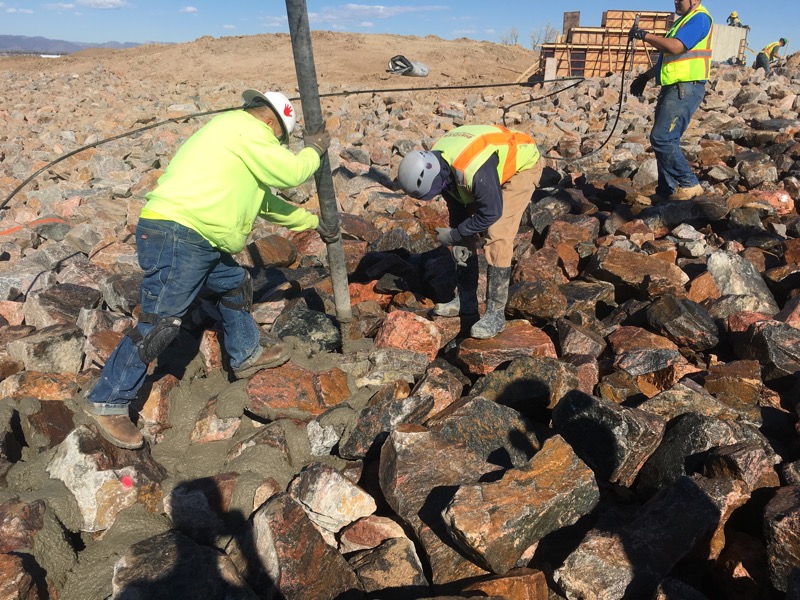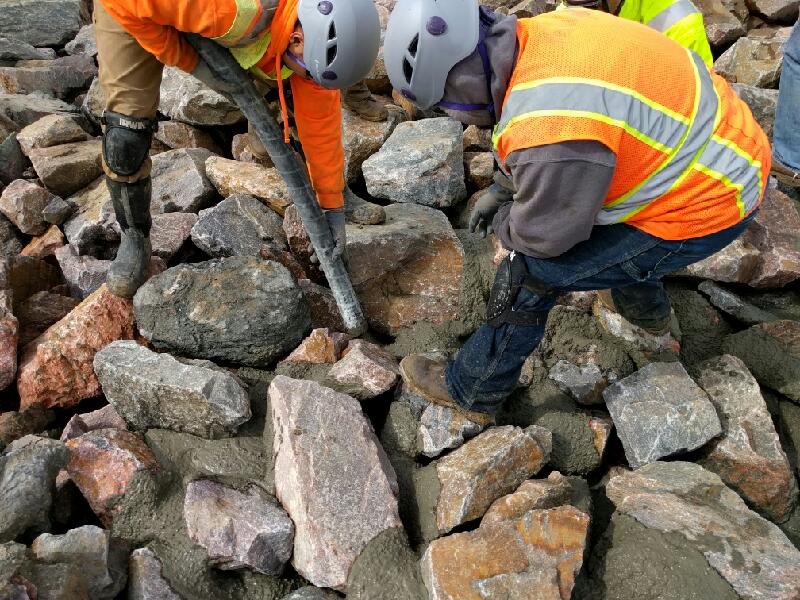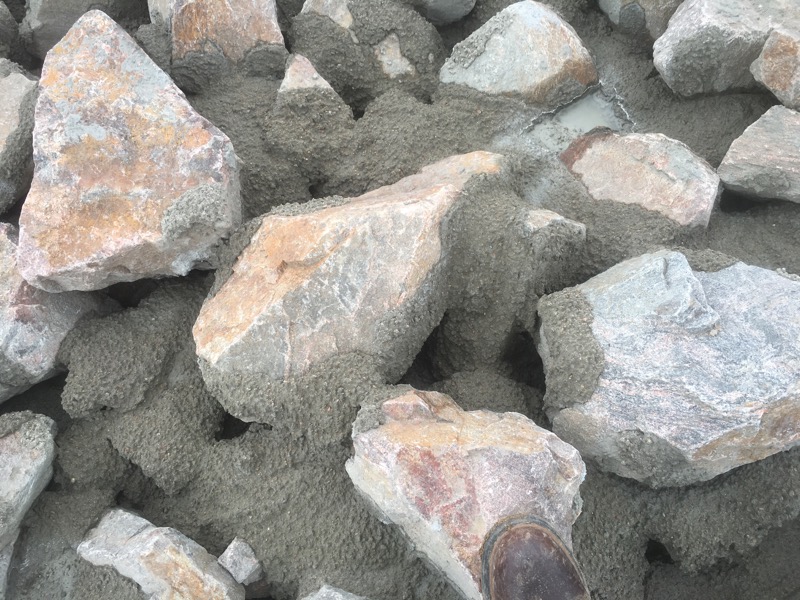Matrix Riprap Provides More Riverbank Protection at Lower Cost
The faster that water rushes through a river, the more erosion occurs on the river’s banks. Riverbank erosion can lead to a host of problems, including compromised bridges and adjacent roadways and loss of property. Protecting riverbanks from erosion correlates directly to increasing public safety. Water moving downhill has  energy, and if that energy cannot be safely dissipated, it will erode a riverbank. Riprap creates a safe channel boundary for the energy to dissipate against. In areas subject to heavy erosion potential, riprap rock is a common option. Using “ordinary” riprap, or loose stone, as an erosion countermeasure to help dissipate the energy of rushing water has historically been an effective tool used by water resources engineers.
energy, and if that energy cannot be safely dissipated, it will erode a riverbank. Riprap creates a safe channel boundary for the energy to dissipate against. In areas subject to heavy erosion potential, riprap rock is a common option. Using “ordinary” riprap, or loose stone, as an erosion countermeasure to help dissipate the energy of rushing water has historically been an effective tool used by water resources engineers.
This practice, however, can be costly. The driving factors for the expense of using ordinary riprap for erosion control is the cost and availability of rock material and the expense of transporting that material to the project location. The traditional method of erosion control on riverbanks involves bringing in large rock (12+ inches in diameter) from quarries that may be 50 miles or more from the project site. The challenge is: How do you provide high quality erosion control in locations with high scour potential while at the same time reducing costs?
Method Tested Over Time
Starting in 1998, Ayres engineer Pete Lagasse worked on research projects with the National Cooperative Highway Research Program (NCHRP) of the Transportation Research Board that developed standards for an erosion control technique – called “partially grouted” or “matrix” riprap – that has been widely used in Europe for the past 30 years but had not yet been used in the United States. This method involves using much smaller-sized rock and “gluing” the pieces together with a cement adhesive mixture. The NCHRP research project, “Countermeasures to Protect Bridge Piers from Scour,” found that in contrast to fully  grouted riprap, which is commonly used in the United States, partial grouting increases the overall stability of the riprap without sacrificing flexibility or permeability. It also allows for the use of smaller rock compared to standard riprap. The research report included investigation of partially grouted riprap installations in Germany and laboratory investigations at Colorado State University at a prototype scale as a basis for developing guidelines applicable to U.S. design and construction practice for this technology. The resulting report summarizes design guidelines for partially grouted “matrix” riprap as a bridge pier scour countermeasure.
grouted riprap, which is commonly used in the United States, partial grouting increases the overall stability of the riprap without sacrificing flexibility or permeability. It also allows for the use of smaller rock compared to standard riprap. The research report included investigation of partially grouted riprap installations in Germany and laboratory investigations at Colorado State University at a prototype scale as a basis for developing guidelines applicable to U.S. design and construction practice for this technology. The resulting report summarizes design guidelines for partially grouted “matrix” riprap as a bridge pier scour countermeasure.
Since the study was published in 2007, we’ve been using matrix riprap in the United States. The federal guidance establishing the state of practice was published in 2009 in a guidance document prepared by Ayres engineers. Since then, the matrix riprap practice has been spreading throughout the United States, resulting in a significant cost saving to project owners while providing the same or improved erosion control performance.
Thinner but More Effective Protection
With the matrix riprap technique, smaller, typically 9- to 12-inch, locally available rocks are strategically placed in layers on the riverbank and then “glued” together on-site with a cement-based grout mixture. This results in an armor layer that is approximately one-half to two-thirds the thickness of a comparably performing ordinary riprap installation. Hydraulic stability with this method is increased significantly over that of loose riprap by providing a much larger conglomerate mass and a high degree of interlocking of the particles created by the adhesive grouting process. Cost savings come through the use of less costly materials – and less of them — and reduced associated transportation costs. The installed cost of matrix riprap can be approximately $150 per square yard versus twice that or more for ordinary riprap installations providing the same level of performance.
Getting Over the Learning Curve
Contractors seem to experience a learning curve when first installing matrix riprap, but this obstacle has been easy to overcome. Contractors receive an orientation on the installation technique and install a “practice pad” to understand the process and get a feel for operating the grouting hose. Proper installation takes a smaller hose and a slow, continuous motion when filling in spaces between the rocks. Areal coverage and the grout’s depth of penetration into the rock matrix are also important factors.
Will deRosset is a hydraulic engineer in our Fort Collins office. Pete Lagasse is a senior hydraulic engineer with Ayres. They are based in Fort Collins and have extensive experience providing water resources research to the NCHRP, the Federal Highway Administration, and other national agencies.

Comments
Interested in rip rap installation in St. Lucie river. 2566569759
Thanks for sharing never did I know my field would lead me to Matrix RipRap.


Post a comment: